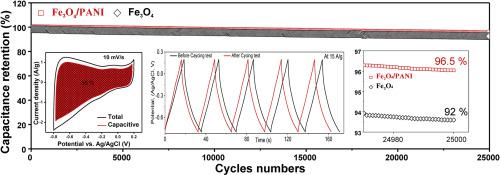International Journal of Hydrogen Energy ( IF 7.2 ) Pub Date : 2020-05-20 , DOI: 10.1016/j.ijhydene.2020.04.173 Muhammad Sufyan Javed , Abdul Jabbar Khan , Muddasir Hanif , Muhammad Tariq Nazir , Shahid Hussain , Muhammad Saleem , Rizwan Raza , Sining Yun , Zhongwu Liu

|
Supercapacitors (SCs) have proven remarkable interest in portable digital devices because of their long life span and high power densities. However, low energy densities of SCs hindered their applications due to the lack of high-performance negative electrode materials. In this work, we demonstrated the successful surface engineering of iron oxide nanoparticles (Fe3O4-NPs) by polyaniline (PANI) coating through a facile low-temperature hydrothermal method. The polyaniline coated iron oxide nanoparticles (Fe3O4/PANI-NPs) were characterized by a series of techniques including XRD, FT-IR, RAMAN, XPS, TGA, BET, SEM, and TEM. Fe3O4-NPs and Fe3O4/PANI-NPs are investigated as negative electrode materials for SCs in basic potassium hydroxide (KOH) electrolyte. The Fe3O4/PANI-NPs sample possesses specific capacitance of 1669.18 F g−1 while Fe3O4-NPs exhibits 1351.13 F g−1 at 1 A g−1 at identical conditions. The Fe3O4/PANI-NPs sample exhibits remarkable electrochemical cycling performance (96.5%) over pristine Fe3O4-NPs (92%) at high current density of 15 A g−1 by exceeding the 25,000 times charge/discharge cycles. The PANI coating not only offers a strong shell to avoid degradation of the material but also contributes to enhancing the capacitance with outstanding stability. Furthermore, we analyzed the charge storage contributions by implementing the power's law and interestingly Fe3O4/PANI-NPs sample exhibits high capacitive type storage (85% capacitive at 10 mVs−1). Based on our experiments, Fe3O4/PANI-NPs shows exceptional high electrochemical results in basic electrolyte with excellent stability and surpass most of recently reported work based on the iron oxides and their composites. Therefore, the proposed strategy can be applied to fabricate the high-performance negative electrode materials for supercapacitors.
中文翻译:

通过聚苯胺包覆的Fe 3 O 4纳米颗粒对超级电容器负极的性能进行设计,可实现高达25,000次循环的高稳定性
超级电容器(SC)的使用寿命长且功率密度高,已引起人们对便携式数字设备的极大兴趣。然而,由于缺乏高性能的负极材料,低能量密度的碳纳米管阻碍了它们的应用。在这项工作中,我们证明了通过简便的低温水热法通过聚苯胺(PANI)涂层对氧化铁纳米颗粒(Fe 3 O 4 -NPs)进行了成功的表面工程设计。聚苯胺包覆的氧化铁纳米颗粒(Fe 3 O 4 / PANI-NPs)通过一系列技术进行表征,包括XRD,FT-IR,RAMAN,XPS,TGA,BET,SEM和TEM。Fe 3 O 4 -NPs和Fe 3 O 4/ PANI-NPs被用作碱性氢氧化钾(KOH)电解质中SC的负极材料。在相同条件下,Fe 3 O 4 / PANI-NPs样品的比电容为1669.18 F g -1,而Fe 3 O 4 -NPs在1 A g -1时显示1351.13 F g -1。在15 A g -1的高电流密度下,Fe 3 O 4 / PANI-NPs样品相对于原始Fe 3 O 4 -NPs(92%)表现出显着的电化学循环性能(96.5%)超过25,000次充电/放电周期。PANI涂层不仅提供坚固的外壳以避免材料降解,而且还有助于以出色的稳定性增强电容。此外,我们通过执行幂定律分析了电荷存储贡献,有趣的是,Fe 3 O 4 / PANI-NPs样品显示出高电容类型的存储(在10 mVs -1时为85%电容)。根据我们的实验,Fe 3 O 4/ PANI-NPs在碱性电解液中显示出优异的高电化学结果,具有出色的稳定性,并超过了最近报道的大多数基于铁氧化物及其复合物的工作。因此,所提出的策略可以应用于制造超级电容器用高性能负极材料。



























 京公网安备 11010802027423号
京公网安备 11010802027423号